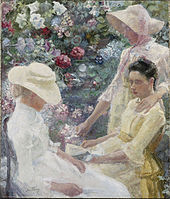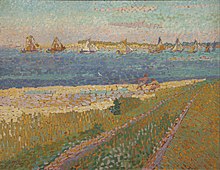Jan Toorop
Johannes Theodorus Toorop (born December 20, 1858 in Purworejo , Java , Dutch East Indies , † March 3, 1928 in The Hague ) was a Dutch painter . Jan Toorop is known mainly as a painter of Art Nouveau and Symbolism . In fact, he was extraordinarily versatile, changing his artistic direction several times over the course of his life and creating works in a number of very different styles.
biography
Toorop was the son of a Dutch colonial official and his British wife. In 1863 the family settled on Bangka , a small island southeast of the Indonesian island of Sumatra , where Jan was baptized in the Protestant church at the age of ten. In 1869, at the age of eleven, he left Indonesia to go to a better school in the Netherlands. In the same year he began teaching at the Gymnasium in Leiden . In 1874 he switched to the school in Winterswijk .
Even as a schoolboy, he enjoyed well-founded artistic training at his schools. In 1875 Toorop settled in The Hague to become a student of Herman Johannes van der Weele . With Weele's commitment, the Hollandse Teekenmaatschappij (Dutch Drawing Society) was formed there the following year . Toorop was involved from the start and made the acquaintance of many artists, including those from the Hague School , such as Johannes Bosboom , Anton Mauve and Hendrik Willem Mesdag .
Toorop then attended the Polytechnic School in Delft for two years , where he was mainly taught by Paul Tétar van Elven . From 1880 to 1881 Toorop studied at the Rijksakademie van beeldende kunsten in Amsterdam and then attended the École des Arts Décoratifs in Brussels until 1886 . At that time Toorop was strongly influenced by Jules Bastien-Lepage , James Ensor and Édouard Manet . In 1883 he went on his first study trip to England. After this trip he moved to the artist colony in Malines, Belgium .
In 1884 he was represented with his own works at the Salon des Indépendants in Paris. In the same year he joined the Belgian avant-garde artist group Les Vingt ( The Twenty ) around Ensor, undertook another study trip to England and visited Paris for the first time. His painting from that year showed strong references to the social problems of his time.
On another study trip to Great Britain in 1885, he met James McNeill Whistler and learned the writings of William Morris on art and socialism and the Pre-Raphaelites . On this trip he also met Annie Hall, whom he married on May 12, 1886.
In 1886 Toorop was the first Dutch painter to use the new pointillism techniques. Toorop suffered from syphilis and in 1887 symptoms of the serious illness set in, which made him blind for a time . In the same year his first daughter Anne Marie died.
In 1888 he lived and worked in Elsene and moved to Great Britain the following year. There he met William Morris personally. In 1890 he moved back to the Netherlands, to Katwijk . He made connections with the Dutch artist group of the Tachtigers ( Eighties ) in Noordwijk and developed his own conception of symbolism, which also included Javanese elements. He got to know this style through the writers Maurice Maeterlinck and Émile Verhaeren .
In 1891 his daughter Charley Toorop was born in Katwijk, who also became known as a painter. In 1892 he was represented with a series of symbolist pictures at the Salon de la Rose-Croix in Paris; for a year he joined the organizing society, the Rosicrucians .
His drawings from 1893 show typical features of Art Nouveau . In 1894 his works were presented to a wider public in England through The Studio magazine . In 1895 he created a large number of copperplate engravings in the Symbolist and Art Nouveau styles, and in this and the two following years he created posters, graphic sheets and illustrations for book covers. In 1888 he was represented at a number of exhibitions outside the Netherlands, including in Dresden, Berlin and Copenhagen. In 1890 and 1902 his works were well received by the public at exhibitions of the Vienna Secession .
After a long period of preparation, he converted to Catholicism in 1905 . The subject of his pictures was now strongly influenced by mystical and religious principles. Stylistically, he turned back to pointillism for a period of two years.
From 1897 Toorop spent the summer months bathing in the sea and relieving his illness in Domburg , lived in the Badhotel in 1898 and in 1899 in the Weststraat with the Drabbe family. Later, until 1920, he stayed in a house on the market. A circle of artist colleagues gathered around him in the seaside resort, including Piet Mondrian , who came to Domburg from 1908. Under Toorop's initiative, a wooden exhibition pavilion was set up in the dunes in 1911. The very simple building, which was soon popularly known as “het Kotje van Toorop”, was about twelve by six meters, had a row of windows on top on all sides and an opening under the high roof through which the sea breeze could blow freely. Mondrian chose the colors. Off-white outside, with a three plank blue band above the floor and a sober decoration of blue circles under the windows. Organized exhibitions were held here in the summer months by artists from Wacheren or those who worked in Wacheren. In 1921, after nine summer exhibitions were held, the “Kunstzaal” collapsed under an autumn storm and was not rebuilt there, diagonally across from Badpaviljoen Domburg. A replica, today's Marie Tak van Poortvliet Museum , designed by the architect Cees Dam (* 1932), opened its doors in the town center in 1994.
In 1908 he moved to Nijmegen . During a trip to Ireland in 1910, many graphics and some paintings were created. In 1913 he met the young artist Miek Janssen , with whom he maintained a close friendship for the rest of his life. In 1914 he made a series of portrait drawings of her.
During the years of the First World War, he painted pictures of the destruction of the war and the plight of the Belgian war refugees, as well as a major religious work, a way of the cross at his new home in The Hague , where he moved in 1916. Due to his severe illness, which was accompanied by physical paralysis, he was severely impaired at work. The Way of the Cross was finally completed and consecrated in 1919; Toorop's paralysis was progressing, however. By 1920 his left leg was completely slack and he was dependent on a wheelchair.
Despite his illness, he continued to work intensively in the following years, mainly creating drawings and graphics that propagated themes and concerns of Catholicism. His last major work was created in 1927, a haunting religiously shaped self-portrait.
Jan Toorop died on March 3, 1928 in The Hague at the age of 69.
Exhibitions
- 2016: Jan Toorop. Song of the times . Villa Stuck , Munich; then 2017 Bröhan Museum , Berlin. Catalog.
Works in museums
- Minneapolis Institute of Arts, Minnesota
- Rijksmuseum Amsterdam
- Dordrechts Museum, Netherlands
- Groninger Museum , Groningen, Netherlands
- Museum of Fine Arts, Boston
- Museum of Fine Arts Collection Database, Boston
- Royal Museum of Fine Arts, Belgium
- Van Gogh Museum , Amsterdam
- Musée d'Orsay, Paris
- Kröller-Müller Museum , Otterlo
- Clemens Sels Museum , Neuss
- Landesmuseum Mainz , Mainz
- Gemeentemuseum The Hague
literature
- Peter van der Coelen: Jan Toorop, portrettist. Waanders, Zwolle 2003, ISBN 90-400-8867-5 .
- Victorine Hefting: Jan Toorop, Een kennismaking. Bakker, Amsterdam 1989, ISBN 90-351-0713-6 .
- P. Begheyn: Autobiographical herinneringen van Jan Toorop, 1858-1886 / printed 1. Waanders, Uitgeverij, Zwolle 2008, ISBN 978-90-400-8543-7 .
- Toorop, Jean Theodoor (1858-1928). In: Biographical Woordenboek van Nederland. (Dutch)
- Francisca van Vloten with contributions by Renée Smithuis and André Groeneveld: Nieuw Licht! Jan Toorop en de Domburgsche Tentoonstellingen 1911-1921 . Uitgeverij De Factory, Deventer, 2011, ISBN 978-90-811727-4-5
Web links
- Literature by and about Jan Toorop in the catalog of the German National Library
- Works by Jan Toorop at Zeno.org .
- Jan Toorop Research Center
Individual evidence
- ^ Marie Tak van Poortvliet Museum Domburg: artist Jan Toorop (1858 - 1928) , on marietakmuseum.nl, accessed on October 4, 2016
- ↑ Het Kotje van Toorop; Domburgse Schilders op een tentoonstelling uit 1912 (Dutch) , on nrc.nl, accessed on October 4, 2016
- ↑ Toorop in Domburg, with photo gallery , on domburg.com, accessed on October 4, 2016
| personal data | |
|---|---|
| SURNAME | Toorop, Jan |
| ALTERNATIVE NAMES | Toorop, Johannes Theodorus |
| BRIEF DESCRIPTION | Dutch painter |
| DATE OF BIRTH | December 20, 1858 |
| PLACE OF BIRTH | Purworejo , Java , Dutch East Indies |
| DATE OF DEATH | March 3, 1928 |
| Place of death | The hague |





